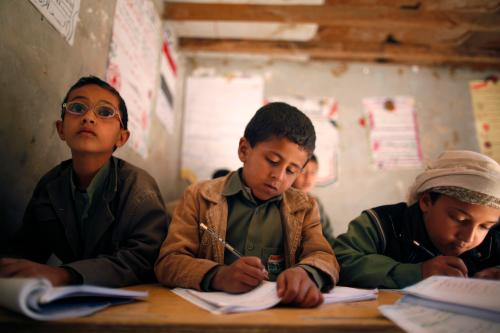This blog was originally published on The Guardian on March 16, 2014.
“Every one else sees the big picture. I see the pixels.”
The psychologist Helen Abadzi said this to me at last year’s World Innovation Summit for Education in Qatar. She worked for almost three decades at the World Bank, applying her expertise in cognitive psychology and neuroscience to the task of improving education.
Her words were a beautiful reminder that behind all the big statistics and fevered debates in education are children. Our big picture is made up of the images of individual children, holding a book, sounding out letters. A child moving from counting to adding and subtracting, and then multiplying and dividing. A child becoming literate and numerate: acquiring the foundation stones of what we all want to be a great education.
The adult sitting with an individual child will be able to assess how much progress he or she is making. But to form a true big picture out of these hundreds of millions of individual experiences, we need a measurement system that works. Our big picture has to be an accurate one, not an erratic jumble of superficial impressions.
Mass measurement of educational outcomes has long been controversial and it continues to be. We measure children’s progress – as it is the only way to measure their progress – through testing. To reliably inform public policy and to shine a light on best practice, those results need to be as transparent as possible. There should be no mystery about how well our children are learning.
In developed countries, testing and transparency are often opposed.Many contend that children will be too stressed by the experience. Really, this is a reflection on how the adults will conduct themselves. If parents and teachers maintain a sense of calm about testing, so will the children.
In any event, at some point during their schooling, and certainly during the course of their adult lives, today’s children will directly face evaluation, feedback and criticism. They will work out how best to respond to a world where being judged is an inevitable part of the process of growing up.
It is also said that education will spiral down to being nothing more than “teaching to the test”. Once again, the adults need to conduct themselves sensibly. Even if they do not, if the tests are well designed for literacy and numeracy then the test is best mastered by increasing the core skills children need.
We are also told that testing cannot measure everything about education. Certainly that is true, but the inability to measure all things should not deter us from measuring what we can – and we can certainly measure the fundamentals of achievement.
Around the globe, there are huge gaps in our understanding of what is happening with children’s education. A data revolution – big and small – is needed. But the sneak peeks we have about what is going on should gravely trouble us.
Critics of testing say the results are meaningless without understanding the backgrounds of the children and the education advantages and disadvantages they bring to school. On this the critics are 100% right, which is why testing information needs to be placed in its proper contexts.
In Australia, as education minister, I created MySchool.edu.au, a website which gives all Australians access to rich and contextualised data about how every school is going, including information about the amount of money available to each school for the task of educating children.
Around the globe, there are huge gaps in our understanding of what is happening with children’s education. A data revolution – big and small – is needed. But the sneak peeks we have about what is going on should gravely trouble us.
Through the Millennium Development Goals, the global community promised the children of the world universal access to primary school education. We are still to make good on that promise to 57 million children.
Even when children do get access to school, true access to learning eludes them. Around 250 million children in developing countries are not reaching basic levels of literacy and numeracy despite many of them having spent four years in school.
As the world debates what should replace the Millennium Development Goals after 2015, there is an increasingly clear focus on the need for a goal that improves both access and learning. A goal that encompasses both more children attending school and receiving a better quality education.
Such a goal can only have meaning if we can measure outcomes and track improving quality. In my capacity as a senior fellow at the Brookings Institution, I have the privilege of seeing up close the global efforts being made through the Learning Metrics Task Force to develop these measures of quality education.
On this Task Force, people of good will and expertise are labouring to design ways of measuring things like reading proficiency and numeracy skills by the end of primary school in a way which can have global applicability, meaning, and ultimately help educators improve students’ learning. Getting the goal right will galvanise our efforts for the children of the world in the most productive way.
Critics of testing and transparency in developed nations often argue that there is no point measuring if no one acts when underperformance is uncovered. This criticism is spot on. Data and transparency shine a light. The onus is on us to respond to what is revealed.
Globally this means a goal set must be a goal attained – for our children and our future.










Commentary
There Should Be No Mystery About How Our Children Are Learning
March 28, 2014